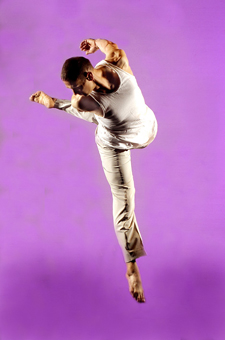“In company”, “L’Après-midi d’un Faune”, “El uno y medio”, “4:Freeze-Frame”
David Hughes Dance Company
Linbury Studio Theatre at Royal Opera House
London, England
September 15 & 16, 2005
by John Percival
copyright ©2005 by John Percival
 David Hughes has been around as a dancer for more than twenty years. How well his newly formed little company will endure, we must wait and see; likewise how he will cope as a choreographer—a trade he is now practising for the first time. He owes his career to a remarkable woman, Nadine Senior, a teacher in Leeds, the Yorkshire city where he grew up. She set out to give all pupils at Harehills School there experience of dance, and Hughes was one of a group who were so inspired that they went on to form their own Images Dance Company. Thereafter he joined several other companies including London Contemporary and Rambert and those of Janet Smith and Siobhan Davies, plus many guest engagements and teaching assignments.
David Hughes has been around as a dancer for more than twenty years. How well his newly formed little company will endure, we must wait and see; likewise how he will cope as a choreographer—a trade he is now practising for the first time. He owes his career to a remarkable woman, Nadine Senior, a teacher in Leeds, the Yorkshire city where he grew up. She set out to give all pupils at Harehills School there experience of dance, and Hughes was one of a group who were so inspired that they went on to form their own Images Dance Company. Thereafter he joined several other companies including London Contemporary and Rambert and those of Janet Smith and Siobhan Davies, plus many guest engagements and teaching assignments.
An important development was creating a one-man dance show (toured nationally) for which he commissioned new solos for himself from four established choreographers—Robert Cohan, Christopher Bruce, Siobhan Davies and Wayne McGregor—with whom he had previously worked. Earlier this year he put together a second one-man show, performed it around Scotland, and has now recruited three other dancers to join him in this new David Hughes Dance Company, launched at (and with help from) Edinburgh Dance Base as part of the Edinburgh Fringe Festival. The new members comprise two women with experience as diverse as his own (Kally Lloyd-Jones and Rachel Morrow—the latter named as assistant director) and a young man, Alan Lambie, not long graduated.
Funding (indicative of a degree of esteem) came also from the Scottish Arts Council’s Lottery Fund towards the major new work, Rafael Bonachela’s group dance “4:Freeze-Frame”—the evening’s best number. Bonachela, born in Barcelona but now London-based, became a prolific choreographer while still a member of Rambert Dance Company; his big break-through came in 2002 when commissioned to create a routine for the pop star Kylie Minogue. While drawing inspiration from the visual arts and popular culture, he says his motivation is the exploration and experimentation of pure movement. I find his assemblage of music this time a little odd, starting with 13th century chanting before contemporary pop from Bioshpere, Nine Inch Nails and Throbbing Gristle (no, really!), but he has invented a variety of movement that responds to the score, mainly couplings that include some interesting quietly quarrelsome confrontations. And the dancers carry it off with conviction, even if the black mini-dresses designed by Txela are not the most flattering garments, especially for the men. Perhaps that’s why the lighting design by Simon Gane suggests that he (like too many of his like nowadays) sees himself as essentially a darkening designer.
Hughes’s own choreography for the other group work, “in company”, comprises mostly multiple turns, jumps and high-kicks. The sequences don’t show too much shape, style or purpose, and don’t really follow from the attractive Vivaldi music accompanying the action.
The programme also includes two solos for Hughes, carried forward from his previous ventures. Siobhan Davies’s version for him of Debussy’s “L’Après-midi d’un faune” is fluent and pleasant enough in its poses and gestures, which just once that I noted directly quoted Nijinsky’s original. But (presumably because it was made as part of a complete one-man show) it does seem to contain a great many of what are best described as resting steps flat on the floor. And it doesn’t express enough character to compare with the dramatic productions made to this score by Nijinsky and Robbins, nor with the solo made to it by Jiri Kylian for his wife.
A programme note indicates that the other solo, “El uno y medio”, with choreography by the Venezuelan born Javier de Frutos to flamenco music, is meant to show Jason mourning his murdered children. Well, presumably the two paintings with spears stuck into them that are prominent in Jean-Marc Puissant’s designs were intended to give a clue, but that’s pretty enigmatic, and anyway they lie sideways and angled so as to be out of sight for many spectators. And the fidgety movement which Hughes is allotted didn’t seem to me very meaningful (Frutos has shown himself in the past capable of far more purposeful dances than this). Mysteriously, Hughes is required twice to stroll disconcertingly offstage and on again; whatever happened to cogency?
The audience in the uncomfortable Linbury Studio Theatre at Covent Garden applauded furiously all evening, but the small auditorium was conspicuously less than full.
Volume 3, No. 34
September 19, 2005
copyright
©2005 John Percival
www.danceviewtimes.com
|
|